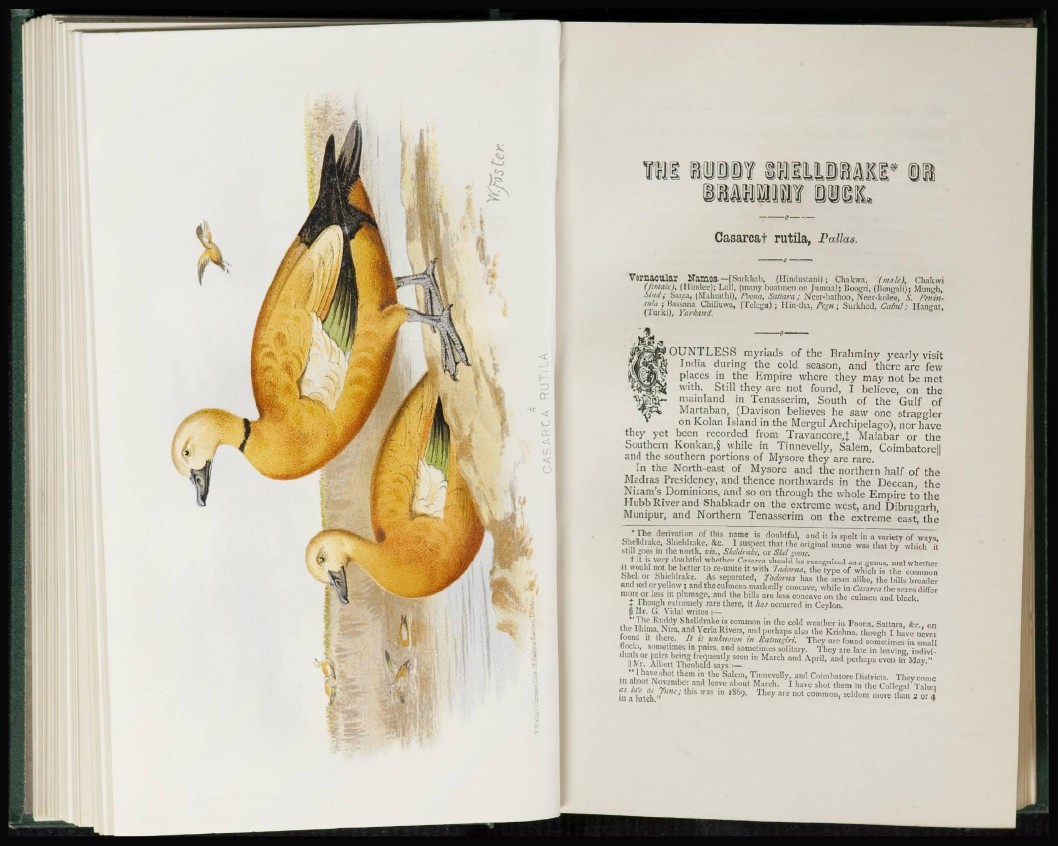
Casarcat rutila, Pallas,
Vernacular STam03-— [Surkhab, (Hindustani); Chakwa, (male), Chakwi
(female), (Hindee)j Lai!, (many boatmen on Jumna); Boogri, (Bengali); Mungh,
Sittd; Sarza, (Maliiallii), Poena, Sahara; Ncer-bathoo, Neer-kolee, S. Peninsula
; Bass'ana Chilluwa, (Telegu) ; Hin-tlia, Pegu ; Surkhed. C'u&ttl; Hangat,
(Turki), Yarkand.
OUNTLESS myriads of the Brahminy yearly visit
India during the cold season, and there arc few
places in the Empire where they may not be met
with. Still they are not found, I believe, on the
mainland in Tenasserim, South of the Gulf of
Martaban, (Davison believes he saw one straggler
on Kolan Island in the Mcrgui Archipelago), nor have
they yet been recorded from Travancore.t Malabar or the
Southern Konkan,§ while in Tinnevelly, Salem, Coimbatorc||
and the southern portions of Mysore they arc rare.
In the North-east of Mysore and the northern half of the
Madias Presidency, and thence northwards in the Deccan, the
Nizam's Dominions, and so on through the whole Empire to the
IIubbRiverand Shabkadr on the extreme west, and Dibrugarh,
Munipur, and Northern Tenasserim on the extreme east, the
* The derivation of this name is doubtful, and it is spelt in a variety of ways,
Shelldrake, Shieldrake, &c, I suspect that the original name was that by which it
still goes in the north, viz., Skeldrakc, or Sid goose,
+ It is very doubtful whether Casarca should be recognized as a genus, and whether
it would not be better to re-unite it with 'ladorna, the type of which is the common
Shell or Shieldrake. As separated, ladorna has the sexes alike, the bills broader
and red or yellow ; and theculmcns markedly concave, while in Casarca the sexes differ
more or less in plumage, and the bills are less concave on the culmcn and black.
% Though extremely rare there, it has occurred in Ceylon.
§ Mr. G. Vidal writes
4 1 The Ruddy Shelldrake is common in the cold weather in Poona, Saltara, &c, on
the Bhiuia, Nira, and Yerla Rivers, and perhaps also the Krishna, though I have never
found it there. is unkutnon in Ratnagiri. They are found sometimes in small
flocks, sometimes in pairs, and sometimes solitary. They are late in leaving, individuals
or pairs being frequently seen in March and April, and perhaps even in May."
|| Mi. Albert Theobald says :—
" I have shot them in the Salem, Tinnevelly, and Coimbatore Districts. They come
in about November and leave about March. I have shut them in the Collegal Taluq
as hk as June; this was in i860. They arc not common, seldom mure than 2 or 4
in a batch."